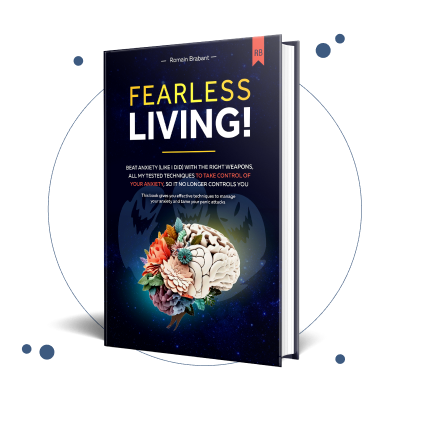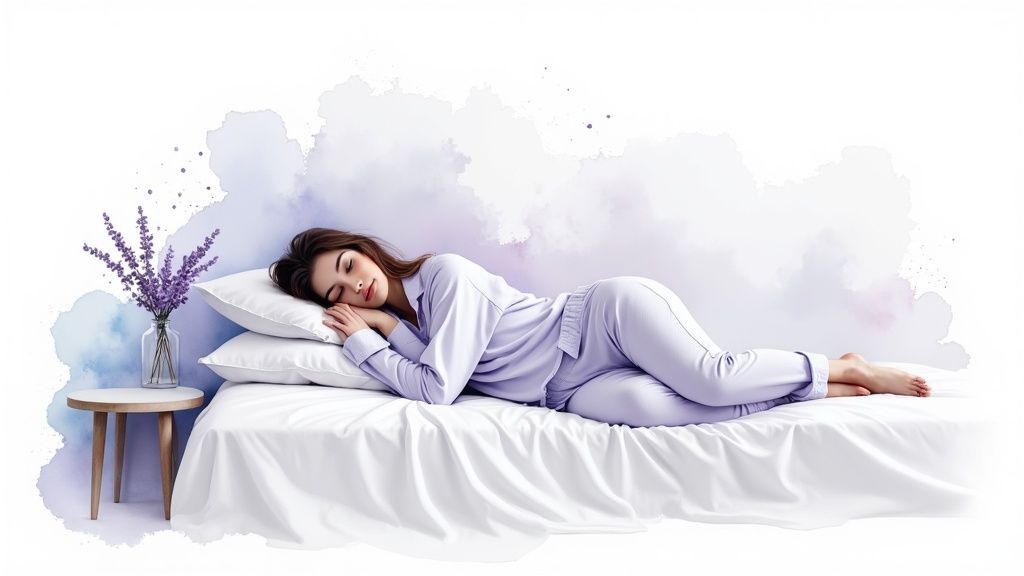
To get a handle on sleeping when you're stressed and anxious, you first have to understand what’s happening in your body that’s keeping you awake. From there, you can learn how to send the right safety signals to your nervous system. This isn't just about coping; it's about healing.
It all comes down to hormones like cortisol and adrenaline. When they kick in, your body goes into ‘protection mode’—a state that makes rest feel totally impossible. But once you understand how to work with your body, not against it, you can learn to guide it back to a place of peace.
Why Stress and Anxiety Sabotage Your Sleep
Ever laid in bed feeling completely exhausted but also wide awake? That’s the classic “wired and tired” paradox. This isn’t just in your head; it’s a powerful biological response running the show. The good news is that it's a response you can learn to manage and ultimately heal.
When your brain senses a threat—whether it’s a real danger, a looming work deadline, or just a vague sense of dread—it hits the panic button. This triggers the release of stress hormones like cortisol and adrenaline.
These chemicals are designed for survival. They jack up your heart rate, sharpen your senses, and get your body ready to either fight or run for your life. It’s an incredibly useful reaction if you’re facing a genuine threat, but it becomes a huge problem when that "threat" is a worry you can't shake at 2 AM. Your body stays on high alert, making deep, restorative sleep feel like a distant dream.
Understanding this process is the first hopeful step toward taking back control of your nights.
The Science Behind Your Sleepless Nights
When your body is stuck in this protective state, it’s simply choosing to be vigilant over being restful. This isn't a personal failing or a sign that you're broken; it's your nervous system just doing its job a little too well.
The racing thoughts, the pounding heart, the feeling that you just can't switch off—these are all symptoms of an overactive threat response system. If this sounds familiar, you can learn more about how to spot your body's fight-or-flight response in our detailed guide.
The impact of this cycle is huge. ResMed's Fifth Annual Global Sleep Survey found that stress (57%) and anxiety (46%) were the top reasons people couldn't get to sleep. This isn't a minor issue; the survey, which included 30,000 people, revealed that we're losing nearly three nights of good sleep every week because of it. You can read the full sleep survey findings to see just how widespread this problem is.
To get a clearer picture of what happens in your body when anxiety strikes at bedtime, let’s break down the key physiological responses. This table summarizes the cycle, helping you connect what you’re feeling with what’s actually going on inside.
The Anxiety and Sleep Disruption Cycle
| Symptom You Feel | What Your Body is Doing | The Impact on Sleep |
|---|---|---|
| Racing thoughts | The prefrontal cortex is on high alert, scanning for threats. | Makes it impossible for your mind to quiet down and drift off. |
| Pounding heart | Adrenaline is surging, increasing your heart rate to pump more blood. | Your body is primed for action, not for rest and relaxation. |
| Restlessness or tossing and turning | Muscles are tense and filled with energy, ready for a physical response. | Deep physical relaxation, which is necessary for sleep, feels out of reach. |
| Feeling "wired" but tired | Cortisol levels are elevated, keeping you alert and awake. | Disrupts your natural sleep-wake cycle (circadian rhythm). |
Recognizing these signs isn’t about adding another thing to worry about. It’s about understanding the "why" behind your sleepless nights so you can start to address the root cause, not just the symptoms.
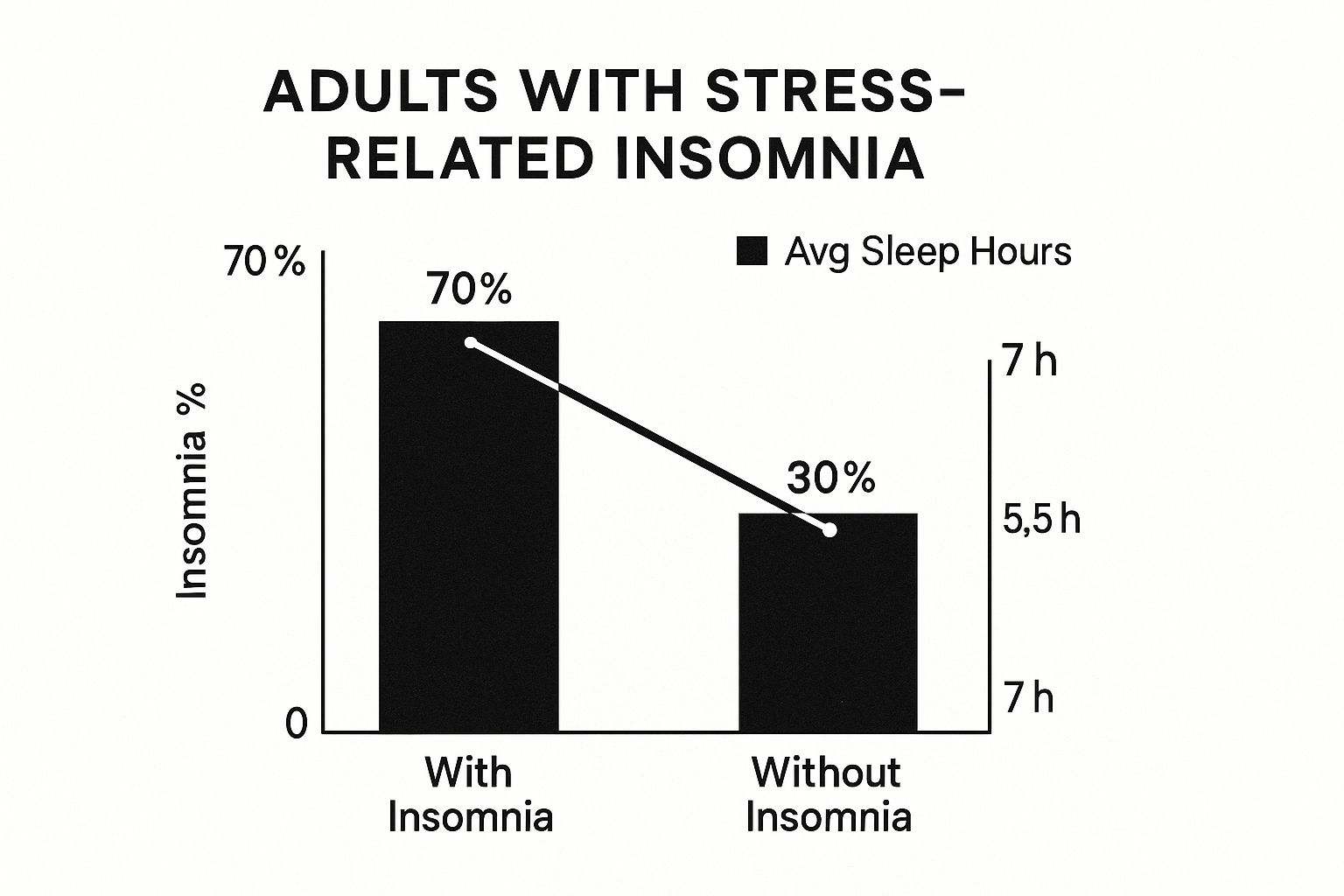
As the data shows, people under stress don't just have higher rates of insomnia—they also get significantly less sleep on average each night.
The good news is that this is a reversible process. By learning to send signals of safety to your nervous system, you can gently guide your body out of protection mode and into a state of calm. This is the foundation for healing from anxiety and living a life free from panic.
Crafting a Pre-Sleep Sanctuary Routine
Your bedroom should feel like a safe harbor, a place where your mind and body can finally let go. When you're struggling with anxiety, it often becomes a battleground for racing thoughts. The key is to transform it back into a sanctuary, and that all starts with a thoughtful pre-sleep routine—your personal "decompression chamber" from the day.
This isn't about generic advice like "read a book." It’s about creating a sequence of actions that intentionally signals to your nervous system that the day is over and it's safe to rest. This routine is your buffer between the chaos of the day and the calm required for sleep.
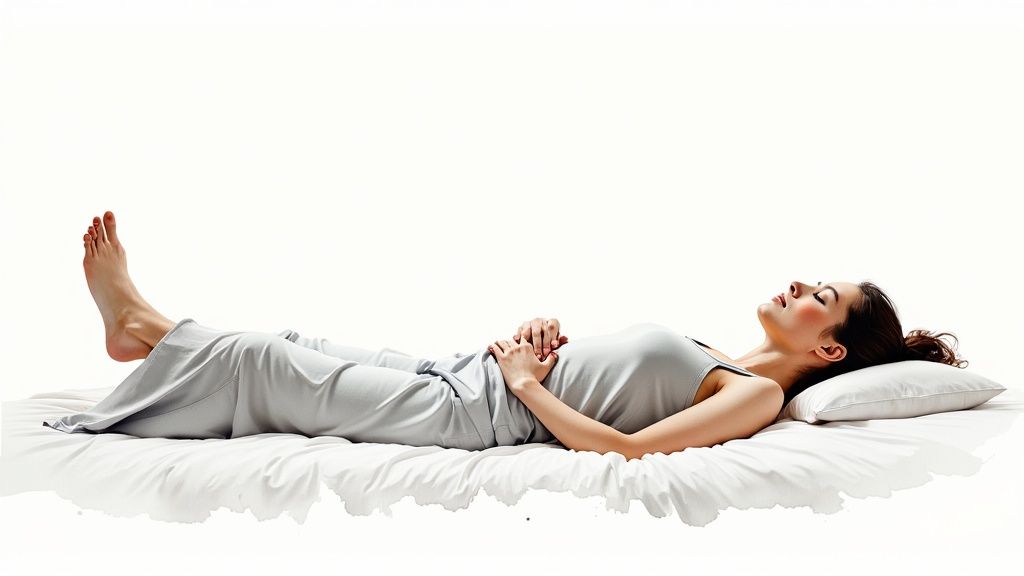
Schedule a Constructive Worry Time
One of the most powerful tools for quieting a racing mind is giving your worries a designated time and place—outside of your bed. This concept, known as constructive worry time, might sound counterintuitive, but it's a profound step towards regaining control.
About an hour before you plan to sleep, set a timer for 15 minutes. Grab a pen and paper and just write down every single thing that’s making you anxious. Don’t filter it. Don't judge it. Just get it all out.
This simple act externalizes your anxieties, moving them from swirling, abstract thoughts inside your head to concrete words on a page. When the timer goes off, close the notebook and physically put it away. You've officially "parked" your worries for the night, giving your brain permission to switch off. If you’d like to explore more about the benefits of journaling for anxiety, it’s a practice that can offer immense relief.
By dedicating a specific window to acknowledge your worries, you teach your brain that bedtime is not the appropriate time for problem-solving. This boundary is crucial for reclaiming your bed as a place of peace, not panic.
Engage Your Senses to Signal Calm
Anxiety keeps your body on high alert, so your routine needs to focus on sensory inputs that communicate safety and relaxation. Think about creating an environment that feels soothing to all your senses.
- Sight: Dim the lights significantly in the hour leading up to bed. Bright lights, especially from screens, are notorious for suppressing melatonin production. Swap out harsh overhead lighting for warm, low-wattage lamps.
- Sound: Go for calming, non-lyrical music or nature sounds. Music with words can sometimes engage the analytical part of your brain, which is exactly what you're trying to quiet down. Ambient sounds can also help mask startling noises and create a consistent, soothing backdrop.
- Smell: Introduce calming scents like lavender or chamomile. Studies have shown that scents like lavender can lower heart rate and blood pressure, physically preparing your body for sleep. A simple essential oil diffuser or a pillow spray can work wonders here.
- Touch: Don't underestimate the feel of your environment. Make sure your bedding is comfortable and the room temperature is cool. Even the fabric of your sleepwear plays a vital role; exploring the right pajamas, such as 100% cotton options, can significantly improve your sleep quality.
When you consistently combine these elements, you create a powerful, multi-sensory cue. Your brain will start to associate this specific atmosphere with winding down, making the transition to sleep smoother and more predictable. This routine isn't just another list of tasks; it’s a compassionate practice that shows you can heal from anxiety and experience peaceful nights once again.
Breathing Techniques to Calm a Racing Mind
When your heart is pounding and thoughts are racing, being told to "just relax" is probably the most infuriating advice you can get. It's not like anxiety has an off-switch.
Instead of trying to fight it head-on, you can use tangible techniques to actively calm your nervous system. This is about more than just calming down; it’s about proving to yourself that you have the power to find peace, even when your mind is screaming otherwise. This is a skill you can build, one breath at a time.
Think of it as giving your body a new set of instructions. While your anxious mind is sending out panic signals, your breath can send back signals of safety. These methods work by directly tapping into your parasympathetic nervous system—your body's natural "rest and digest" mode—to counteract that frantic fight-or-flight response.
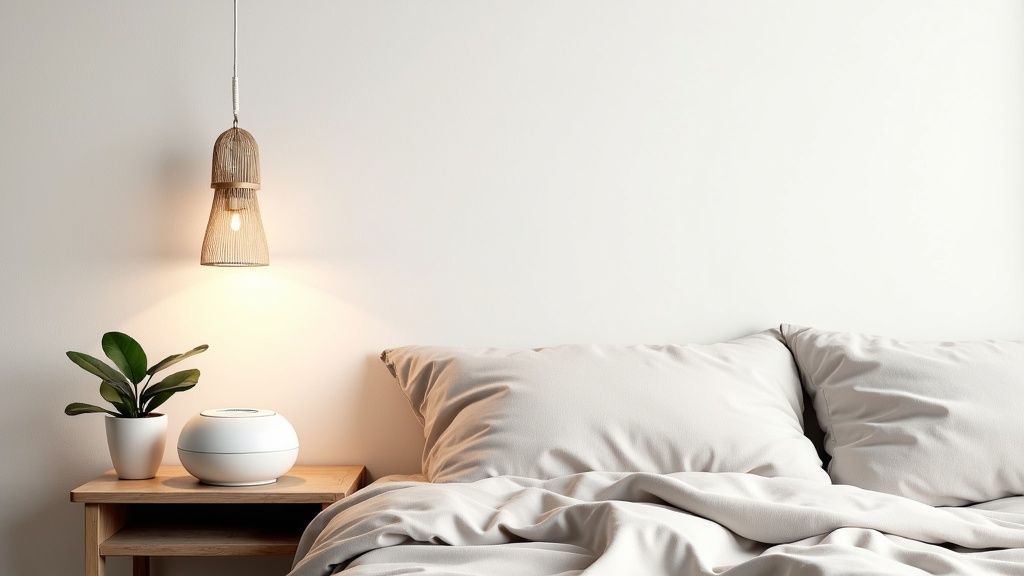
Master the 4-7-8 Breathing Technique
The 4-7-8 breathing method is a simple but surprisingly potent tool you can use anytime, anywhere. It's especially useful when you're lying in bed and feel that familiar wave of panic start to build. Its power is in its rhythm, which helps slow your heart rate and gives you a much-needed sense of control.
Here’s how to do it in that exact moment:
- Exhale completely through your mouth, making a gentle whooshing sound. Get all the stale air out.
- Close your mouth and inhale quietly through your nose for a mental count of four.
- Hold your breath for a count of seven. This is the most important part. It lets the oxygen really fill your lungs and circulate through your body.
- Exhale completely through your mouth, making that whoosh sound again, for a count of eight.
Try to repeat this cycle three or four times. Don't get too hung up on the exact numbers; the key is making your exhale twice as long as your inhale. That extended exhale is what really flips the switch on your body’s relaxation response. For more ways to use your breath to your advantage, you can explore other breathing exercises for anxiety.
By concentrating on the physical feeling of your breath and the simple rhythm of the count, you give your mind a concrete job to do. This interrupts the obsessive loop of anxious thoughts and grounds you in the present moment, reminding you that peace is always accessible.
Ground Yourself with a Body Scan Meditation
Another powerful technique for when your mind just won't shut up is the body scan. This practice is all about bringing a gentle, non-judgmental awareness to different parts of your body, one by one. You're not trying to force relaxation—you're just noticing what's there.
Imagine you're lying in bed, your shoulders are tight, and your stomach is in knots. Start by bringing your full attention to the toes on your left foot. Just… notice them. Are they warm? Cold? Tense? Simply observe without trying to change a thing.
From there, slowly guide your awareness up through your body:
- Your feet and ankles
- Your calves and shins
- Your knees and thighs
- Your hips and pelvis
- Your stomach and lower back
- Your chest and upper back
- Your arms, hands, and fingers
- Finally, your neck, face, and head
As you scan, you'll probably notice spots of tension you weren't even aware of. The goal isn't to fix them, but just to acknowledge them. Often, the simple act of noticing is enough to allow that tension to release on its own. This process pulls your mind away from abstract worries and anchors it to physical sensations.
Your Plan for Waking Up Anxious at 3 AM
It’s one of the worst parts of anxiety—that jarring jolt from sleep at 3 AM. Your heart pounds, your mind instantly floods with dread, and sleep feels a million miles away. You're alone in the dark, and it can feel terrifying.
But this moment doesn't have to hijack your night. With a plan, you can learn to move through it with compassion and confidence. This is not a sign of failure; it's an opportunity to practice your skills and show yourself you can find your way back to calm.
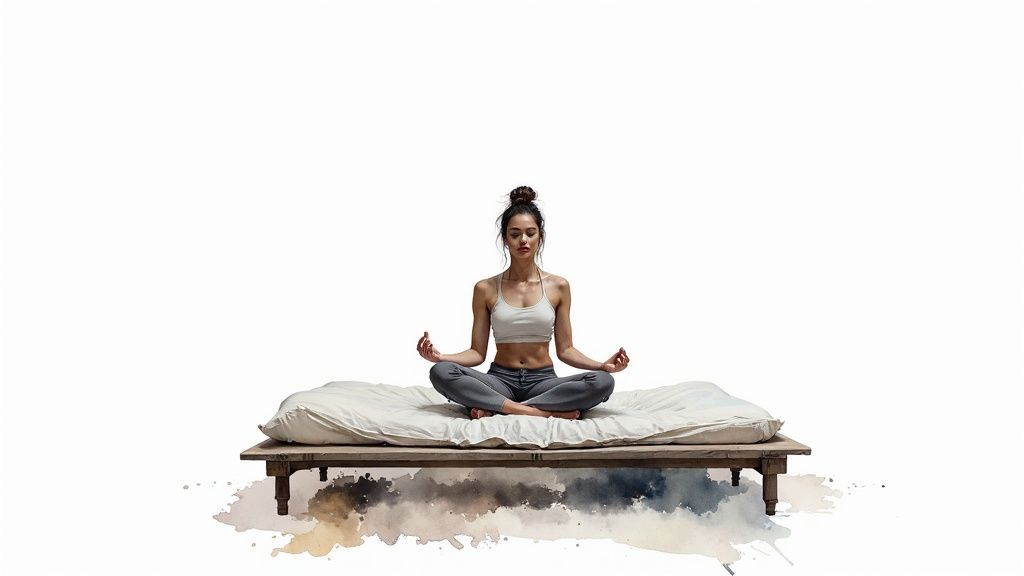
First things first, I have two non-negotiable rules for you. Do not check the time. Seriously. Looking at the clock only feeds the anxiety. It kicks off that frantic mental math about how much (or how little) sleep you have left before the alarm goes off.
Rule number two: Resist the urge to grab your phone. The blue light is the enemy of sleep, and scrolling through content will only wake your brain up more.
The 20-Minute Reset Rule
If you’ve been lying there for what feels like 20 minutes—tossing, turning, and wrestling with racing thoughts—it's time for a reset. Lying in bed any longer just strengthens the connection in your brain between your bed and a state of anxious wakefulness. We need to break that cycle.
Getting out of bed is a powerful move. It's an act of self-compassion that signals you're taking control, not just lying there as a victim of your anxiety. This isn't giving up on sleep; it's a practical step toward making it possible again.
This gentle "reset" is a core part of retraining your nervous system. It teaches your brain that the bedroom is for rest, and that you have a safe, effective plan for moments of panic, reinforcing the hope that you can and will heal.
Create a Calm, Boring Escape
Your destination should be another room with very dim, warm lighting. The goal isn't to start your day, it's to find a calm, boring activity that helps your mind gently unhook from its anxious loop. This is not the time to do chores or catch up on work.
Here are a few ideas that work for my clients:
- Read something dull. I mean really dull. A technical manual, a dry textbook, or even a catalog. The goal is boredom, not entertainment.
- Do a simple puzzle. A jigsaw puzzle or a Sudoku puzzle can occupy your mind just enough without being overly stimulating.
- Listen to calming audio. Put on a guided meditation or some soft, non-lyrical music to soothe your nervous system.
While you're in this space, you can also practice simple grounding techniques for anxiety to bring your focus back to the present. If waking up in the middle of the night is a common thing for you, exploring additional strategies to stop waking up at 3 AM can give you more targeted guidance.
Once you start to feel genuinely sleepy again—your eyes getting heavy, your thoughts slowing down—head back to bed. This protocol isn’t just a quick fix. It’s a repeatable strategy that proves you can navigate these difficult nights and builds your confidence, one peaceful morning at a time.
Building Long-Term Resilience to Sleep Anxiety
Getting a single good night's sleep feels like a massive win when you're struggling. But the real goal is to make peaceful sleep your new normal, not a rare treat. This is where we shift from short-term fixes to building a life where anxiety doesn't run the show anymore.
Think of it as a journey of healing, not a race. By making small, consistent changes, you can start to rewire your brain’s response to stress. You are not broken; your nervous system has simply learned a pattern that it can also unlearn. You deserve restful nights and joyful days, and it's absolutely possible to reclaim them.
Create a Foundation with Daily Habits
Long-term resilience isn’t built in the frantic minutes before you try to sleep. It’s cultivated throughout your day with simple habits that support your body’s natural rhythms. These small actions create a strong foundation that makes falling asleep at night feel less like a battle.
Two of the most powerful habits are surprisingly simple:
- Morning Sunlight: Get outside for 10-15 minutes of direct sunlight within the first hour of waking up. This one little thing helps anchor your circadian rhythm—your internal clock that tells your body when to be alert and when to feel sleepy. It's one of the strongest signals you can send your brain to get back on track.
- Gentle Movement: Regular, gentle exercise is incredibly effective at burning off stress hormones. I’m not talking about intense, grueling workouts. A brisk walk, some yoga, or even just stretching will do. The goal is consistent movement that helps your body process all that nervous energy long before your head hits the pillow.
Rewiring Your Brain for Calm
Beyond daily habits, building real resilience means changing your relationship with those anxious thoughts that pop up at 3 AM. This is where learning how your brain works can make a huge difference.
By understanding and challenging the thought patterns that fuel nighttime anxiety, you can take back control. If you want to go deeper, you can understand CBT for anxiety in our guide. This approach gives you practical tools to identify, question, and reframe the fears that are keeping you awake.
You have the power to change how you respond to anxiety. Every time you choose a constructive habit over a worry cycle, you are strengthening new neural pathways in your brain—pathways that lead to calm and confidence instead of fear and panic.
This process is about creating lasting change, not just finding another coping mechanism. And the ripple effect of consistent, quality sleep goes far beyond just feeling rested. It can fundamentally improve your entire quality of life.
Research from The National Sleep Foundation shows that adults who are satisfied with their sleep are 45% more likely to experience flourishing in their lives. The report also found that those who don't have frequent trouble falling asleep are 47% more likely to flourish, showing a direct link between restful nights and overall well-being. You can discover more about the findings on sleep and life satisfaction in their full report.
By committing to these long-term strategies, you're not just learning how to sleep when stressed; you're building a life where anxiety no longer calls the shots. Healing is possible, and those peaceful nights you've been dreaming of are absolutely within your reach.
Common Questions About Sleep and Anxiety
When you’re staring at the ceiling at 3 AM, your mind racing, it’s only natural for questions to pop up. Am I the only one going through this? Is my sleep permanently broken? Let's clear the air and tackle some of the most common worries people have about anxiety and sleep.
Getting straight answers is more than just satisfying your curiosity—it’s a crucial step toward taking back control. Knowledge is power, especially when you're learning to calm your own nervous system. The path to peaceful nights is real, and it often starts with answers that offer clarity and hope.
Can Stress Permanently Damage My Sleep?
This is a big one. After weeks, months, or even years of restless nights, it's easy to fear that your natural ability to sleep is gone for good.
Here’s the hopeful truth: for the vast majority of people, this simply isn't true. Chronic stress can absolutely create a deeply ingrained habit of poor sleep, but your body and brain are incredibly resilient and designed to heal.
Think of it this way: your sleep system isn’t broken, it has just learned a pattern of being on high alert. Your job now is to gently teach it a new one. By consistently using calming techniques and building new sleep-friendly habits, you can retrain your nervous system to see your bed as a safe place for rest, not a battleground for worry. You can absolutely restore your natural ability to sleep.
What Is the Difference Between Stress and Anxiety at Night?
They feel incredibly similar when you're lying awake, but there's a subtle and important distinction.
Stress is typically a reaction to a specific, external pressure—like a looming work deadline, a tense conversation, or a financial problem. Once that issue is resolved, the feeling of being "on" usually fades.
Anxiety, on the other hand, is often more internal and self-sustaining. It’s the worry that sticks around even when there’s no immediate threat. It's your mind spinning on future "what-ifs" or replaying conversations from the past. While stress can definitely trigger anxiety, anxiety can also run on its own, creating a vicious cycle of worry that keeps sleep at bay.
Healing means tackling both. You need strategies to manage the external stressors in your life, but you also need tools to change your relationship with the internal patterns of worry. This dual approach is what creates real, lasting freedom from panic.
Is It Okay to Use Sleep Aids?
Sleep aids, whether over-the-counter or prescription, can sometimes offer a lifeline during a particularly rough patch. There's no shame in needing short-term relief.
However, they aren't a long-term solution for healing anxiety-driven insomnia. Most sleep aids don't get to the root of the problem—an overactive mind and nervous system. They can also lead to dependency or interfere with the natural, restorative stages of your sleep cycle.
The most powerful and sustainable strategy is to build the skills to calm your own mind and body. The techniques in this guide, from breathing exercises to cognitive reframing, are designed to make you your own sleep solution. This is where true healing from anxiety begins. It’s about building an unshakable confidence in your own ability to find peace, night after night.
At The Anxiety Checklist, we believe you deserve a life free from the grip of anxiety. If you're tired of just coping and ready to start truly healing, our Fearless Living system offers a clear, actionable path forward. It’s a complete toolkit designed to help you understand, manage, and finally overcome anxiety so you can reclaim your nights—and your life. Learn more and start your journey to fearless living today.

